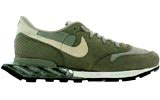Absorbing Shox
Nike claims the soles of its new Shox system trainers are inspired by Formula One cars. John Cooper tests how quick off the grid they are

There was a time when Nike was a cult brand. It was a groovy company in America’s pacific Northwest that cared about the needs of athletes, but also produced the kind of footwear that looked good on the streets.
Nike has a history of innovation: from the waffle sole, developed for running shoes; to the Cross Trainer, a multipurpose shoe which, when it was introduced in the mid-1980s, was the epitome of cool to a young gym junkie such as myself. Then they released the Air Jordan and backed it up with an ad campaign penned by Spike Lee – who, in the late 1980s, had the kind of reputation that Spike Jonze currently enjoys.
The innovation didn’t end there, though. In the 1990s Nike Air pockets, used to improve cushioning grew, culminating in the ubiquitous silver Air Max running shoes that retailed for £120 and were seen on the feet of every fashion victim in Soho.
The air pockets in the heel were an innovation that virtually every shoe manufacturer picked up on. The principal of a vacuum filled with pressurised air was inspired: improved cushioning with minimum weight. But now Nike has gone one step further. Its new Shox system has thrown out the air pocket altogether; there is now a hollow under the heel of the shoe, with four sprung supports in place of a conventional sole. According to Nike, the inspiration for the system was a device that reduces shock and vibration in formula one cars. The principle is that the supports give you spring. This system should appeal to any designer who believes in the less is more maxim, but does it work?
I took the new Shox basketball boot down the gym for a workout. In fairness to Nike, I didn’t actually play basketball in them. But then how many flygirls and boys will actually be playing basketball in them? These shoes may be designed for the basketball court, but they will spend most of their life pounding the pavement. Back in the gym, the new Shox system started out feeling good, if a little firm. But five minutes of pounding on the treadmill soon revealed that the Shox system is rock hard. If that isn’t enough, the cut-away heel section robs the shoes of any lateral support and the rest of the shoe felt about as secure as a carpet slipper. At £120, Shox are going to be targeting the hardcore athlete (or the hardcore poser).
I didn’t do much jumping around in them – maybe if I was jumping (or capable of jumping) a couple of metres into the air on my way to a slamdunk I would need firmer cushioning in my shoes. In truth, I should have tried the Shox running shoes, or better still, the cross training version – both of which have a larger hollow underneath the heel and longer columns, which hopefully means more spring – but neither were available for review.
So the Shox system doesn’t work very well. Nike has a policy of only sponsoring athletes. In contrast, LA Gear once sponsored Michael Jackson in his Bad phase – the result was a shoe that looked like a cross between a trainer and a biker boot, with extra buckles. Maybe this is exactly what Nike is trying to avoid. But this does not mean that the public only invests in Nikes to play sport.
The new Shox are odd-looking; they don’t look like other trainers. Previous Nike designs may have been created for sport, but they coincidentally looked pretty good as casual wear. Perhaps Nike’s reputation is so solid that people will immediately accept the new look, but it seems like the company is sticking its neck out, especially when you consider that the sportswear giant recently re-released the original Air Jordans, a shoe that not only performs well, but also looks great. I know which shoe I’d buy.
The Nike Shox basketball shoe is released on 1 February, priced £120
-
Post a comment



